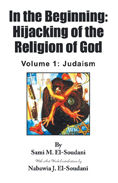
 |
In the Beginning: Hijacking of the Religion of God, Volume 1: Judaism
by Sami M. El-Soudani
Westwood Books Publishing LLC
This remarkable treatise comprises a far-reaching exploration of the origins and outcomes of three of the world’s great and interrelated religions: Judaism, Christianity, and Islam. It is based on an amusing but nonetheless profound premise: “Men practiced hijacking long before they had wings.”
In this, the initial volume of three, author El-Soudani examines the established, monotheistic creed on which the Torah and the Bible are based. The first hijacking of the Jewish faith happened only shortly after God spoke to Moses when some Israelites reverted to the worship of Baal, the so-named “golden calf,” to retain a physical representation of the deity. This opened the way for many rituals that had no relation to the truths purveyed through Moses. It is also crucial to the understanding of how Judaism developed, El-Soudani states, to recognize that the word of God given to Moses and known as the Torah was spread by word of mouth, “and only after many generations was it set down in writing.” Thus it contains anachronisms and contradictions, comprising another of the hijackings referred to in the title, as priests, under the sway of changing governments, made of Judaism what would be most favorable to the current regime.
A second major hijacking, quite critical to the position of Judaism in today’s world, was the growth of Zionism, propagated by Jews and non-Jews alike from the early 1800s onwards. By giving or relegating Jews to an ephemeral “state” occupied by those of another religion, the creed of Zion evolved into an ethos of power and self-protection that has led to war, terrorism, mistrust, and fear.
This first volume in El-Soudani’s series is the result of an educated, well-trained intellect confronting and determinedly elucidating a subject generally thought of as intuitive or even anti-intellectual. He takes on the task with evident zeal. Even in this first portion, concentrated on the earliest of the three religions, he draws comparisons and extrapolations with the other two. For example, he demonstrates in fine detail how Paul, who never met Jesus, created a complex, often contradictory creed based on the name of Jesus Christ, yet far, many would say, from Jesus’ real life and teachings. According to the author, this illustrates one of the many ways that religion can be hijacked for personal advantage, arrogance, power-mania, and greed.
El-Soudani modestly sets forth in a lengthy introduction his qualifications for creating this work. He researched vast amounts of material for twenty years. He brings to his writing an intense organizational focus based on his professional experience in the field of fracture mechanics and failure analysis of structures and materials. He is a Moslem married to a Christian and has sought with his spouse to convey spiritual truth to their children, determined that they should understand the “religion of God” in its purest form. He devised a 95-page series of “fault-tree analysis charts” that pinpoint the many major and minor hijackings of all three religions in a year-by-year format. He worked closely with his daughter who provides emotive illustrations of some of the belief stressors posited in the book. And he shows his talent as a poet in a gently rhyming encapsulation of the factual material that ends with a positive message: “with every daybreak, there is a new beginning with God.” El-Soudani’s work in totality deserves a careful and open-minded study by anyone drawn to a broad, logic-based understanding of issues that affect us all.
RECOMMENDED by the US Review